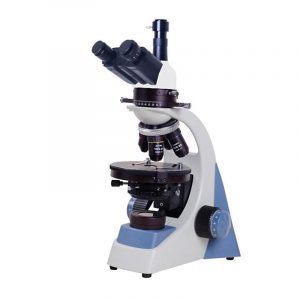偏光显微镜: 光的特殊性质的科学之旅
偏光显微镜是一种独特类型的显微镜,利用光的偏振特性, allowing us to study and identify substances with birefringent properties in depth. These microscopes can perform single-polarized, quadrature polarized, and cone-light observations, helping scientists understand the optical properties of matter.

Polarization characteristics of light:
Before we can understand how a polarizing microscope works, we need to understand the polarization properties of light. Light is an electromagnetic wave that usually travels evenly in all directions of vibration. 然而, under certain conditions, the vibration of light can be limited to one direction, which is called polarized light. Polarized light is usually produced by a polarizer, which only allows light in a particular vibrational direction to pass through.
How the polarizing microscope works:
Polarizing microscopes use polarizers and polarizers to adjust the polarization direction of light to explore the optical properties of matter. These instruments can be divided into the following modes:
偏光显微镜: 光的特殊性质的科学之旅
Single polarizing observation
In this mode, with only one polarizer and one polarizer, the light passes through the sample and is broken down into two beams that vibrate in different directions before merging again. This allows the observation of birefringence properties in the sample.
Orthogonal polarization observation
This mode uses two polarizers whose vibration directions are orthogonal to each other. This can help identify whether a substance is unirefringent (isotropic) or birefringent (anisotropic), since isotropic substances do not change the polarization state of light.
Cone-light observation
Cone-light observation is a special mode of polarized light microscopy commonly used for mineralogical studies. It uses a special lens system to generate cone light, further improving the observation of the sample.
Transmitted light, falling light (reflected light) and reflected light:
In a polarizing microscope, light can interact with the sample in different ways, including transmitted light, falling light (reflected light), and reflected light:
Transmitted light: This is how light passes through the sample and travels to the microscope. The transmitted light is used to observe the internal structure of the sample, such as the birefringent properties of the crystal.
Falling light (reflected light) : 在这种情况下, the light is reflected back so that the surface of the sample is observed. This is very useful for studying surface morphology and properties.
Reflected light: Reflected light is a combined mode in which light both passes through the inside of the sample and is reflected back. This allows observation of the inside and surface of the sample.
偏光显微镜: 光的特殊性质的科学之旅
应用领域:
Polarizing microscopes are widely used in many fields such as materials science, 地质学, mineralogy, biology and pharmacy. They help scientists study the structure of crystals, the birefringence properties of materials, and the orientation of tiny crystals and fibers. 此外, polarizing microscopes are used to identify minerals, observe optical structures in biological samples, and study the properties of crystalline drugs in pharmacy.
综上所述, polarization microscopy is a powerful scientific tool that allows us to delve into the optical properties and structure of matter through the polarization properties of light. Its multiple modes and ways of viewing provide researchers with a wealth of information that helps unlock many mysteries in the natural and materials worlds. Polarizing microscopes are scientific Windows into the beauty of light, giving us a deeper understanding of the complexity of nature and matter.
